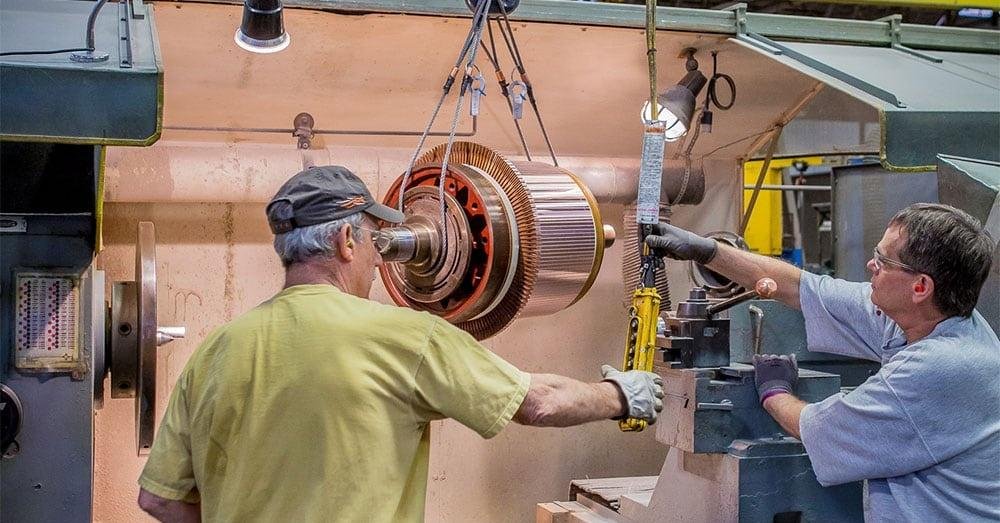Are you curious to know what is commutation in DC machine? You have come to the right place as I am going to tell you everything about commutation in DC machine in a very simple explanation. Without further discussion let’s begin to know what is commutation in DC machine?
In the world of electrical engineering, direct current (DC) machines play a vital role in various applications, from electric vehicles to industrial machinery. One critical aspect of DC machines is commutation, a process that ensures the flow of current in the right direction and, consequently, the smooth operation of the machine. In this blog, we will explore what commutation is in DC machines, its significance, and how it impacts the performance of these electrical devices.
What Is Commutation In DC Machine?
Commutation in a DC machine refers to the process of reversing the direction of current in the armature windings at the precise moment when the armature coil crosses the neutral plane within the magnetic field. This reversal of current direction is essential for maintaining a unidirectional (DC) output from a machine that inherently generates an alternating current (AC) in the armature windings.
Significance Of Commutation
Commutation is of paramount importance in DC machines for several reasons:
- Maintenance of Polarity: It ensures that the output voltage or current remains in the same polarity or direction. This is crucial for applications where a consistent and unidirectional power supply is required.
- Efficient Power Generation: DC machines are often used when a steady and controllable power supply is needed. Effective commutation ensures that the output voltage or current is relatively stable, making DC machines suitable for various applications.
- Reduction of Electrical Noise: Proper commutation minimizes electrical noise and interference generated by the machine. In applications where noise is a concern, such as audio equipment, maintaining clean and stable DC output is crucial.
- Prevention of Armature Reaction: Commutation helps counteract the armature reaction, an effect in DC machines where the armature’s magnetic field distorts the main magnetic field. This distortion can lead to performance issues if not properly managed.
- Extended Machine Lifespan: Effective commutation reduces wear and tear on the brushes and commutator, extending the lifespan of the DC machine and minimizing maintenance requirements.
The Commutation Process
The commutation process involves a few key steps:
- Armature Rotation: As the armature rotates within the magnetic field created by the field windings, the conductors within the armature windings move relative to the field’s magnetic lines.
- Armature Coil Crossing the Neutral Plane: At a certain point in the rotation, the armature coil crosses the neutral plane, where the current direction should ideally be reversed.
- Brush-Commutator Interaction: The commutation process is facilitated by brushes, which are typically made of carbon. The brushes make physical contact with the commutator, which is a segmented, cylindrical copper or metal disc mounted on the armature shaft.
- Reversal of Current: When the armature coil crosses the neutral plane, the brushes slide from one commutator segment to another. This transition results in a reversal of the current direction in the coil, ensuring that the output remains in the desired polarity.
On GetDailyBuzz you will get to know beneficial information which required in your daily life.
Challenges In Commutation
While commutation is crucial for the proper operation of DC machines, it is not without challenges. Factors like brush wear, uneven commutator surfaces, and excessive current levels can lead to commutation problems, including sparking and poor machine performance. Engineers and technicians must address these issues through maintenance, design improvements, and proper sizing of components.
Conclusion
Commutation is a fundamental process in DC machines that allows for the generation of steady and unidirectional electrical output. Its role in maintaining the machine’s efficiency, reliability, and overall performance cannot be overstated. Understanding the intricacies of commutation is essential for engineers and technicians working with DC machines, as it enables them to optimize machine operation and address any issues that may arise during its lifespan.
FAQ
What Is Commutation In DC Machine Pdf?
By commutation we mean the changes that take place in an armature coil during the period that it is short-circuited by a brush. These changes are illustrated in figure 1, the winding being represented as a ring winding for simplicity.
What Does Commutation In A DC Motor Cause?
The change from a generated alternating current to the direct current applied involves the process of Commutation. When the conductors of the armature are under the north pole, the current which is induced flows in one direction. While the current flows in the opposite direction when they are under the south pole.
What Is The Function Of Commutator?
The function of commutator rings is to reverse the direction of current flowing through the coil after every half rotation.
What Are The Types Of Commutation?
The commutation techniques of thyristors are classified into two types:
- Class A: Self commutated by a resonating load.
- Class B: Self commutated by an LC circuit.
- Class C: Cor L-C switched by another load-carrying SCR.
- Class D: …
- Class E: An external pulse source for commutation.
- Class F: AC line commutation.
I Have Covered All The Following Queries And Topics In The Above Article
What Is Commutation In DC Machine With Diagram
What Is Commutation In DC Machine In Physics
What Is Commutation In DC Machine And Generator
Commutation In DC Machine Pdf
What Is Commutation In DC Machine Ppt
Types Of Commutation In DC Machine
Effect Of Commutation In DC Machine
Delayed Commutation In DC Machine
What Is Commutation In DC Machine
What is commutation in detail

